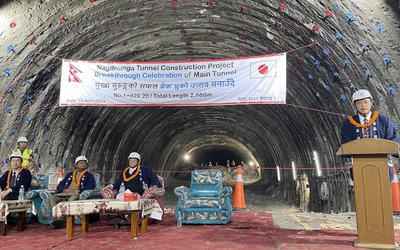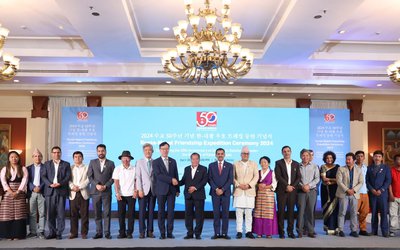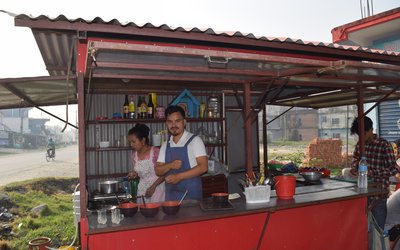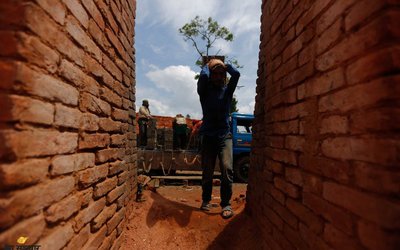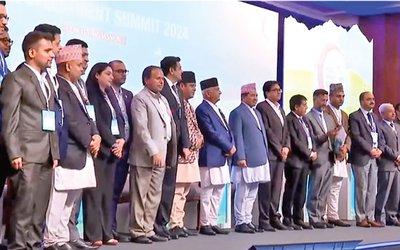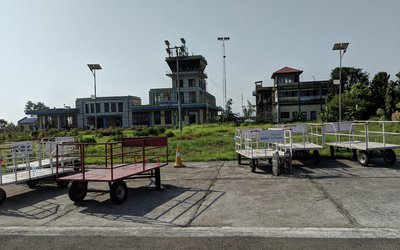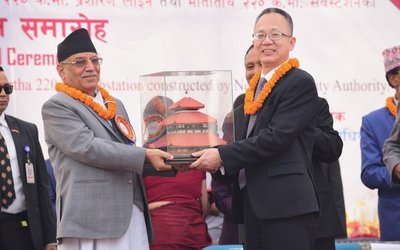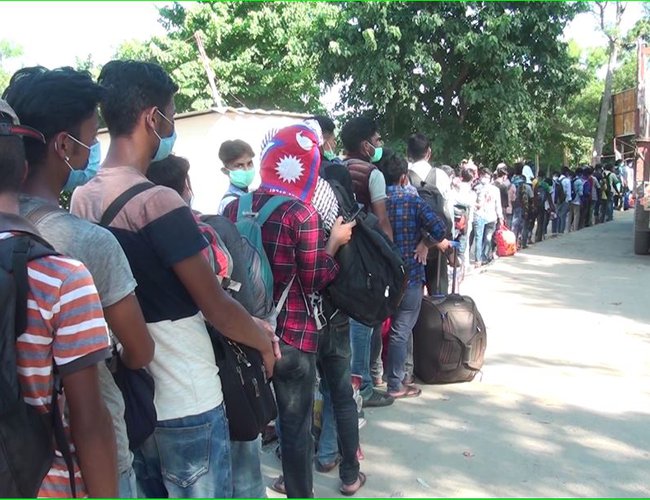
Raj Kumar Chaudhary of Ghoda Ghodi Municipality-3, who has been working in India for the last 15 years, said, "I am returning to India because of the lack of job opportunities here in my home country, Nepal.
Lokendra used to work at a shopping complex in New Delhi as a security guard for the last five years and had returned four months ago. Others like him too had to leave their jobs in India to return to their hometowns.
"Malls have opened in India. I got to join my duty. It has been four months since I reached Nepal to skip the pandemic but I have got nothing to do here. At least I have a job in India with which I am able to meet the expenses of my family. I am therefore thinking about returning to India for the work which is there for me. My employer has been for weeks asking me to return, so I am off to New Delhi," Lokendra said.
More than a thousand workers from Nepal have been crossing the Customs at Kailali District of Southern Plain of Nepal to rejoin their jobs in India.
Although the exact number of Nepali migrant workers is not recorded by any government institutions, thousands of Nepalese are working in India. People of various age groups go to India on annual basis mainly from Far-Western Nepal which has become a means of living for them.
As no visa or permit is required to work in India, various cities there have been job centers for Nepali workers. Likewise, thousands of Indian workers from Bihar and Uttar Pradesh also crossed the border to work in various sectors in Nepal recently.
With the rise in COVID-19 cases in India during the month of March and the imposition of lockdown in India, more than two hundred thousand Nepali migrant workers had returned to Nepal. Now with business falling back to track in India despite a rising number of cases there, Nepali workers despite knowing the risk are flocking to India for jobs.
With the economy in India gathering pace again, thousands of workers from Nepal have been crossing the customs point at Kailali District of Southern Plain of Nepal to rejoin their jobs in India.
A report quoted a migrant worker as saying, “Malls have opened in India. I got to join my duty. It has been four months since I reached Nepal to skip the pandemic but I have got nothing to do here. At least I have a job in India with which I am able to meet the expenses of my family. I am therefore thinking about returning to India for the work which is there for me. My employer has been for a week asking me to return, so I am off to New Delhi.”
The Covid-19 lockdown in March had made more than 2, 00,000 Nepali migrant workers return to Nepal.
Closed border Open Mobility
Nepal shares borders with two neighbors, India on the South and China on the North. Following the spread of coronavirus, Nepal has completely shut down the borders with China and India.
Despite shutting down human mobility from Nepal, India always keeps its borders open for the export and import of goods and human mobility. India’s border is the lifeline for Nepal’s national economy and a lifeline for people.
With insistence from Chinese authorities, Nepal’s two main trading ports with China are yet to open. Goods worth billions of rupees has been lying on the Chinese side of the border due to the border shutdown by Chinese authorities citing the COVID-19.
Although Nepal is yet to officially open its borders with the southern neighbor India for the mobility of people, India has allowed desperate Nepalese seeking to go back for employment, which is the means of survival for their families.
According to officials, over 500,000 Nepalese have already entered India from four border points including Gaddachauki, Gaurifanta of the far west, Ruapadiya and Sunauli of Province 5.
Coronavirus infections have been surging and there is a threat of infection, people of far-western Nepal, who rely on employment opportunity in India, have started to return for employment.
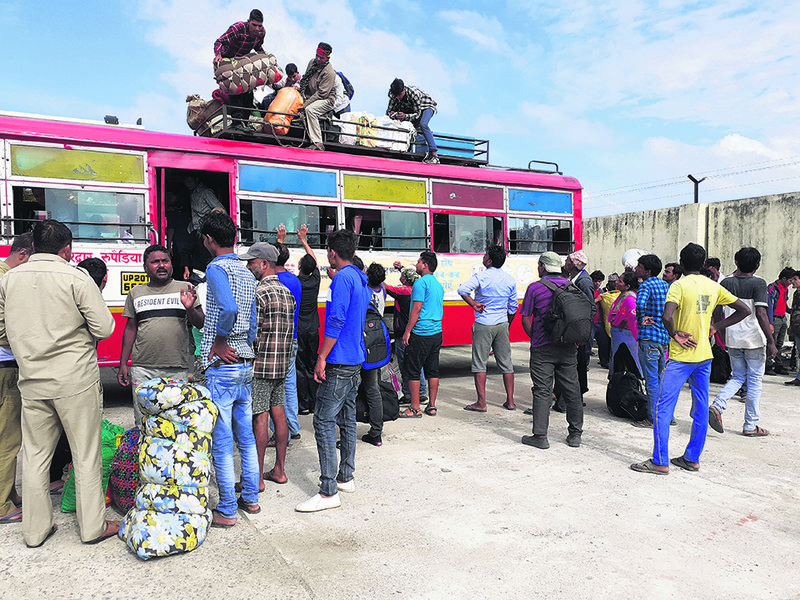
As India is a main destination of employment for an overwhelming number of Nepalese people in far-west and Karnali province, Province 5 and Gandaki, the remittances generated from India is a source of livelihood.
Migration From Farwest
The COVID-19 pandemic is forcing an exceptional level of reverse migration of Nepali migrant workers from the destination countries and places. The current global pandemic is increasing health and safety risks.
There are reports of migrant workers being unemployed, unpaid, and at the mercy of the employers, resulting in them living off their inadequate savings. Nepal began to see a significant influx of migrant returnee people from India as India saw an increase in new cases throughout the country.
Nepali migrant workers coming from India struggled to get back as India announced its own nationwide lockdown from March 25. Many walked hundreds of miles through the Indian lockdown and finally came to the border towns and entered Nepal from designated 20 border points.
DCA-Nepal Study
According to DCA-Nepal, the organization has been working in the Sudur Paschim Province on the migration issue and conducted several studies and research aftermath of COVID-19.
A study “COVID-19 Impact on Migrants Workers” in Kanchanpur, Doti, Achham and Kailali District, with 1572 migrant returnees” conducted by DCA, a Danish Development and Humanitarian Agency through its local partners in Sudur Paschim Province shows that 98.7% of migrant’s returnee have lost their household livelihood due to COVID-19.
For full report:https://reliefweb.int/report/nepal/survey-report-covid-19-impact-migrants-workers-sudurpashchim-pradesh
In addition to the other early recovery programs, DCA is planning to support 8 cooperatives in Doti and Achham Districts with a seed grant, that will be mobilized to design appropriate low-interest loan products for the potential migrant returnees, which will support them to start income generation activities.
Samjhana Bista, Head of the Programs, said that a Survey Report “COVID-19 Impact on Migrants Workers” in Sudurpashchim Pradesh highlighted various aspects of migration and migrant workers.
The study undertaken by DCA-Nepal identify the impact of COVID-19 on migrant workers in Kanchanpur, Kailali, Doti and Achham districts, the situation is dim in Sudurpaschim.
The COVID-19 pandemic is forcing an exceptional level of reverse migration of Nepali migrant workers from the destination countries and places. The current global pandemic is increasing health and safety risks.
There are reports of migrant workers being unemployed, unpaid, and at the mercy of the employers, resulting in them living off their inadequate savings. Nepal began to see a significant influx of migrant returnee people from India as India saw an increase in new cases throughout the country.
Nepali migrant workers coming from India struggled to get back as India announced its own nationwide lockdown from March 25. Many walked hundreds of miles through the Indian lockdown and finally came to the border towns and enter Nepal from designated 20 border points.
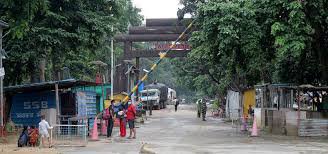
This study was undertaken to identify the impact of COVID-19 on Migrant workers in Kanchanpur, Kailali, Doti and Achham district. It covered 1,572 migrant’s returnees. The multistage stratified systematic random sampling method was adopted to identify the respondents for the survey. The majority 94.3%, were male.
The mean age of the migrant’s returnee is 29 years. 33.8% of respondents have studied up to grade 6 to 10. Most of the migrant’s returnee HHs (78.4%) fall into the vulnerability category. 19.4 % of the respondents stated that they have a person with Disability (PWD) family members in the HHs and 64.1% of respondents fall under Poor and Food Insecure (PFI) household. 97.1% of migrant returnees come back from abroad, while 2.9% returned from other districts of Nepal. Of the respondents that returned from abroad, 98.2% returned from India, while 1.8% returned from Gulf countries i.e. Dubai, Qatar, and Saudi Arabia.
98.7% of migrant’s returnees have lost their household livelihood due to COVID-19. The key reasons for the disruption in their current livelihoods activities are (i) shutdown of markets due to lockdown,
(ii) had to stay at home to look after their children due to school closures, (iii) impact on markets due to the economic downturn (iv) travel restrictions and contract termination were also a reason for livelihood loss.
The main food source for the HHS is its crop production, livestock rearing, and purchasing from the market. 12% of migrant’s returnee HHs do not have food stock; whereas 37.8% have food stock for 3 months and 30.8% have food stock for 6 months.
Likewise, 38.2% of the respondents purchase more than half of the food items from the market. 40.8% of respondents believe that their local marker places are not safe in terms of the spread of COVID-19.
The women’s workload has increased significantly after the COVID-19 pandemic; 77.2% agreed that women’s workload has increased mainly in terms of preparing and managing food for their family, taking care of their children and livestock. Mostly, 84.1% adult female member and 73.4% adult male members of the family is most stressed in the current situation. 57.5% agreed that the risk of Gender-Based Violence has increased. There is a need to create livelihood opportunities for the migrant’s returnee to make an environment to use their skill. Of returnees, 56.2% have agriculture-related skills; 35.5% have cooking skills, 6.5% have housing construction skills; 6.3% have iron smith skill, 5.2% are skilled in driving. Similarly, 5.4% have tailoring and driving skills respectively.
In another, COVID-19 Socio-economic Survey Report - Humanitarian Response Team DCA Nepal Office conducted on June 17, 2020, also reveals many interesting parts.
The study of socio-demographic characteristics of respondents showed that the mean age of the respondents was 34 years, with 62.3% of the respondents being between the age group of 25 to 44 years.
Most of the HHS (45.1%) fall into the vulnerability category of poor/food insecure. 37.7% of the respondents stated that they have a vulnerable member in their family i.e., elderly people in their HH and 12.3% have a Person with Disability (PwD).

There is a need to revive their livelihoods by creating new income generation opportunities in the communities with special financial and technical support in collaboration with the local government (LG).
The major source of income for livelihood is daily agriculture and non-agricultural wage labor (61.3%) followed by subsistence farming (59.8%) and seasonal employment (17.2%).
The HHS has stated that the key three reasons (multiple responses) for the disruption in their livelihoods activities are (i) closure of market due to lockdown (87.7%),(ii) need to take care of the children due to school closure (66.2%) and (iii) losing agriculture and non-agriculture related wage labor opportunities (41.2%). 47.5% HHs reported that more than half of their HH supplies come from the market.
There is a need to create livelihood opportunities for the migrant returnees - an environment where they are able to use the skills that they have learned in their host countries such as cooking, vocational skill for manufacturing industries, modern agriculture practices, etc. for income generation. The majority (60%) of the migrant returnees reported that they spent 1-10 years working abroad. The jobs mainly consisted of working in hotel/restaurants, security guards, cook and “other work” which including working as a receptionist, gardener, care-taker and in the assembly line of factories.
The three main sources of food for the HHs is from their own crop production, livestock rearing and purchasing from the market. Most of the HHs have sufficient food stock for less than 3 months. 52% HHs agreed that COVID-19 has already had an impact on their sustenance, whereas 44.6% HHs are expecting a negative impact if the current situation continues. 53.9% HHs agreed that they are having additional health issues due to food scarcity. The issue of food insufficiency is becoming a big challenge in those communities. Thus, there is a need to address this emerging problem on time.
Going Back
With no employment opportunity back home, large numbers of Nepalese, who returned home after a lockdown in March, have started to return to India. Although Nepal is yet to formally announce the opening of the border, India has been allowing Nepalese migrant workers to return in their place in India.
However, this is not the same with Indian citizens who want to come to Nepal. With a decision of banning the border till October, Indians have to wait to enter Nepal through official borders.
However, Nepal opened its border for trade with India even during the complete lockdown. As a result of the global COVID-19 pandemic, Nepal has, like many other countries, implemented lockdown measures to curb the spread of the deadly virus.
Amid the COVID-19 pandemic, the Nepali returnees from India have now started going back to India because of the lack of food and employment at home despite the risk of contraction of the virus.
Dinesh Thakhulla, an official at the Citizen Help Desk at Trinagar border in Dhangadhi, Kailali, said, “In recent times, more than 1000 migrant workers are returning to India on a day.”
The police deployed at Trinagar post said that the migrant workers go to Mumbai, Pune, Delhi, and Lucknow through the Gaurifanta border point. As the number of Nepalis going back to India has increased, Indian authorities at the Indian border side have made it compulsory to show the ration card or Nepalese citizenship to enter India.
“It’s easier to fight the virus than hunger. So I am going to work in India as a migrant worker,” said Kripa Ram Niraula, 50, a resident of Punarbas Municipality- 6, Kanchanpur, who has been a migrant worker in India for 22 years. Niraula made the comment while entering India through the Ghaurifanta border point.
Another migrant worker, Kemraj Chaudhary of Bardagoriya, Kailali, who has been working in India for the last 6 years, said, "If I do not go to India for earning, then my family of four will die from hunger.” He is more worried about unemployment than getting infected with the virus.

Keshab Poudel
Poudel is the editor of New Spotlight Magazine.
- MoICS/IFAD: SAMRIDDHI’S Leading To Apprenticeship
- May 01, 2024
- MoICS AND IFAD: SAMRIDDHI For Entrepreneur And Employment
- Apr 29, 2024
- IWMI: SoLAR Global Science-Policy Forum Conference
- Apr 25, 2024
- CLA: Samriddhi For Skill Development
- Apr 23, 2024
- ECONOMY: Growth At 3.3
- Apr 16, 2024

